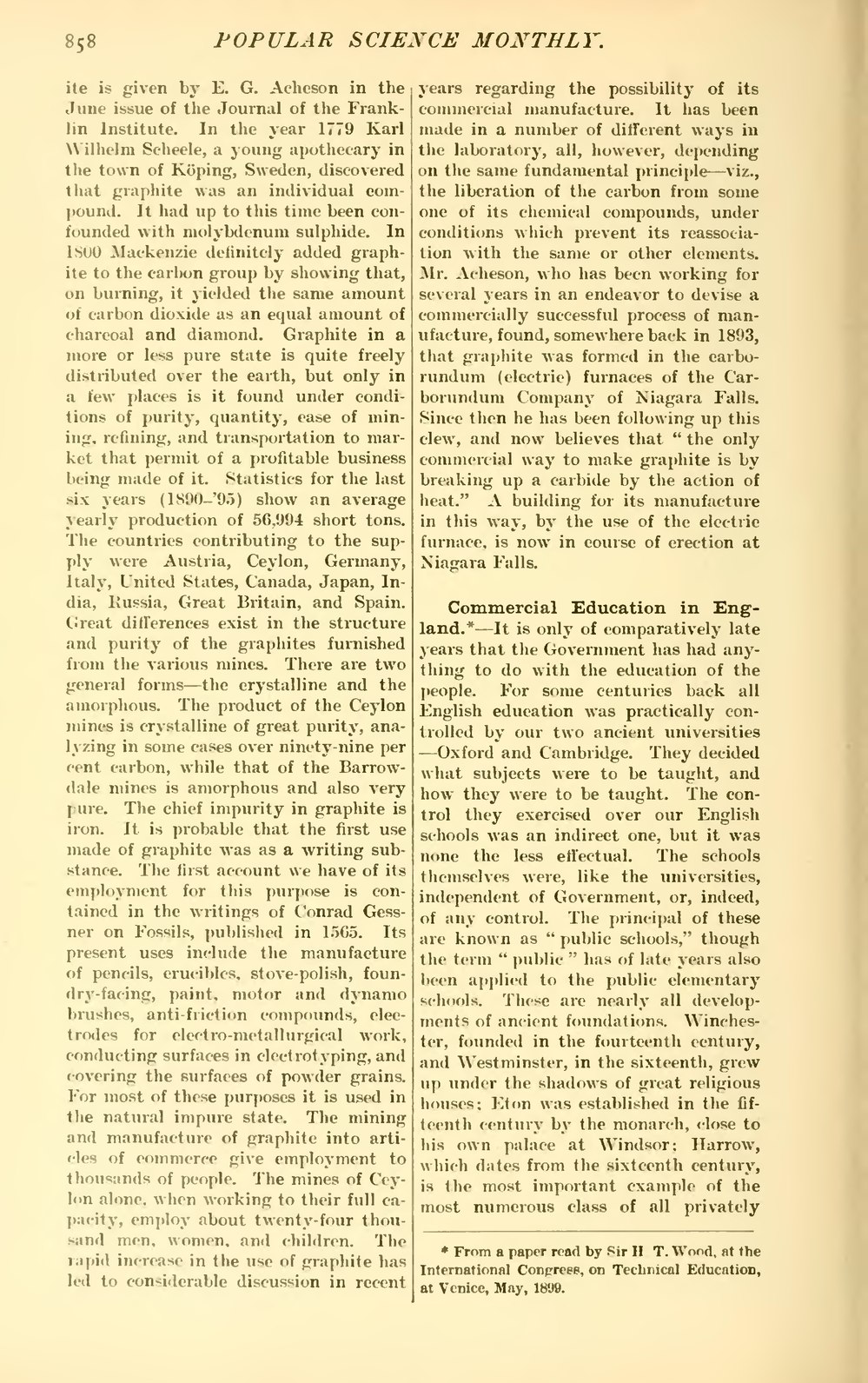ite is given by E. G. Acheson in the June issue of the Journal of the Franklin Institute. In the year 1779 Karl Wilhelm Scheele, a young apothecary in the town of Köping, Sweden, discovered that graphite was an individual compound. It had up to this time been confounded with molybdenum sulphide. In 1800 Mackenzie definitely added graphite to the carbon group by showing that, on burning, it yielded the same amount of carbon dioxide as an equal amount of charcoal and diamond. Graphite in a more or less pure state is quite freely distributed over the earth, but only in a few places is it found under conditions of purity, quantity, ease of mining, refining, and transportation to market that permit of a profitable business being made of it. Statistics for the last six years (1890-'95) show an average yearly production of 56,994 short tons. The countries contributing to the supply were Austria, Ceylon, Germany, Italy, United States, Canada, Japan, India, Russia, Great Britain, and Spain. Great differences exist in the structure and purity of the graphites furnished from the various mines. There are two general forms—the crystalline and the amorphous. The product of the Ceylon mines is crystalline of great purity, analyzing in some cases over ninety-nine per cent carbon, while that of the Barrowdale mines is amorphous and also very pure. The chief impurity in graphite is iron. It is probable that the first use made of graphite was as a writing substance. The first account we have of its employment for this purpose is contained in the writings of Conrad Gessner on Fossils, published in 1565. Its present uses include the manufacture of pencils, crucibles, stove-polish, foundry-facing, paint, motor and dynamo brushes, anti-friction compounds, electrodes for electro-metallurgical work, conducting surfaces in electrotyping, and covering the surfaces of powder grains. For most of these purposes it is used in the natural impure state. The mining and manufacture of graphite into articles of commerce give employment to thousands of people. The mines of Ceylon alone, when working to their full capacity, employ about twenty-four thousand men, women, and children. The rapid increase in the use of graphite has led to considerable discussion in recent years regarding the possibility of its commercial manufacture. It has been made in a number of different ways in the laboratory, all, however, depending on the same fundamental principle—viz., the liberation of the carbon from some one of its chemical compounds, under conditions which prevent its reassociation with the same or other elements. Mr. Acheson, who has been working for several years in an endeavor to devise a commercially successful process of manufacture, found, somewhere back in 1893, that graphite was formed in the carborundum (electric) furnaces of the Carborundum Company of Niagara Falls. Since then he has been following up this clew, and now believes that "the only commercial way to make graphite is by breaking up a carbide by the action of heat." A building for its manufacture in this way, by the use of the electric furnace, is now in course of erection at Niagara Falls.
Commercial Education in England.[1]—It is only of comparatively late years that the Government has had anything to do with the education of the people. For some centuries back all English education was practically controlled by our two ancient universities—Oxford and Cambridge. They decided what subjects were to be taught, and how they were to be taught. The control they exercised over our English schools was an indirect one, but it was none the less effectual. The schools themselves were, like the universities, independent of Government, or, indeed, of any control. The principal of these are known as "public schools," though the term "public" has of late years also been applied to the public elementary schools. These are nearly all developments of ancient foundations. Winchester, founded in the fourteenth century, and Westminster, in the sixteenth, grew up under the shadows of great religious houses; Eton was established in the fifteenth century by the monarch, close to his own palace at Windsor; Harrow, which dates from the sixteenth century, is the most important example of the most numerous class of all privately
- ↑ From a paper read by Sir H. T. Wood, at the International Congress, on Technical Education, at Venice, May, 1809.

